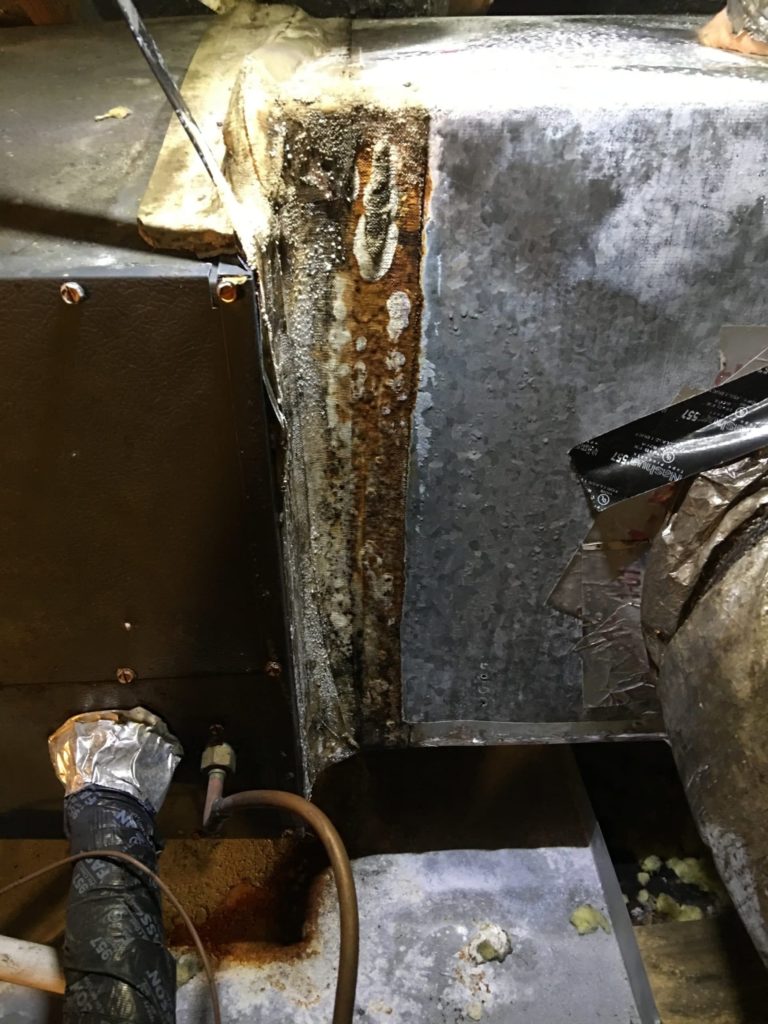Mold on air conditioners is disgusting and hazardous, leaving homeowners wondering where everything went wrong and how to fix it. Here’s everything you need to know about mold in your AC system.
How Does It Happen?
Mold is common in dark, damp, dirty places, which provide the perfect environment for it to thrive. Unfortunately, AC systems meet this description perfectly.
Mold spores naturally travel in the air and attach to damp areas where they start to grow. AC technicians often find mold on the exterior of air conditioning systems and ducts rather than the interior. Some problem areas for mold are:
- Supply plenum
- Air vents
- Flex ducts
- Trunk line
How To Eliminate Mold
Mold cannot grow in environments that lack moisture. If you get rid of the moisture, you’ll keep the mold from growing.
In HVAC systems, moisture occurs due to hot and cold temperatures mixing. It’s the same reason cold beverages sweat and create condensation. The difference between the two situations is that condensation on air conditioners happens for a long time.
When looking for causes and cures for mold growth, you should ask two primary questions:
- What is causing water to form?
- How do I eliminate the water/moisture?
Stopping Mold In Problem Areas
Supply Plenum
The supply plenum is a box that connects to your HVAC system’s supply outlet. Your AC’s blower system sends warm or cool air inside of the supply plenum. Air is then distributed into your home throughout the ductwork.
To prevent mold from growing on your supply plenum, you should:
- Have a professional remeasure the duct sizing to ensure proper airflow through the system.
- Replace the plenum with a higher insulation R-value.
- Increase the distance between ducts.

Mold buildup on evaporator coil and supply plenum due to improper duct sizing and insulation value.
Air Vents
If black spots have appeared around your air vent, this is a sign of mold. You can stop mold growth by:
- Replacing the grill, ensuring proper size and fit.
- Properly sealing to make sure no attic air is penetrating through the supply box.
- Making sure that the home does not have outside air filtration (often caused by construction, negative pressure, etc.).

Mold on an improperly installed air vent.
Flex Ducts
Flex ducts are long and flexible tubes that distribute air within your home. Mold has the ability to form in these tubes but can be prevented.
To ensure your flex ducts aren’t growing mold, you should:
- Have a professional measure the ducts to ensure proper airflow through the system.
- Keep flex ducts from touching. Ducts that touch create condensation.
- Install a dehumidifier for the attic air, reducing the opportunity for condensation to form.

Mold on flex ducts that are touching.
Duct Board Trunk Lines
Your home’s duct board can occasionally form mold. To prevent mold growth, you can:
- Replace the duct board with properly sized ducts.
- Increase insulation value.
- Eliminate cold air leakage.

Mold on duct board trunk line.
Maintaining Good Indoor Air Quality
Mold exposure can cause numerous health issues. Many people have reactions such as shortness of breath, fever or wheezing. Over time, mold can seriously detriment your long-term well-being.
Mold counts are usually higher in the Houston area. Having good indoor air quality is a household essential and the key to maintaining your health. UV light installation and regular tune-ups can help prevent airborne bacteria and mold on air conditioners.
Contact Us!
Mold on air conditioning systems is easily avoidable with proper installation practices and system design. If you have mold on your AC system, contact Mission AC for Houston AC repair, and let our experts eliminate it fast.



